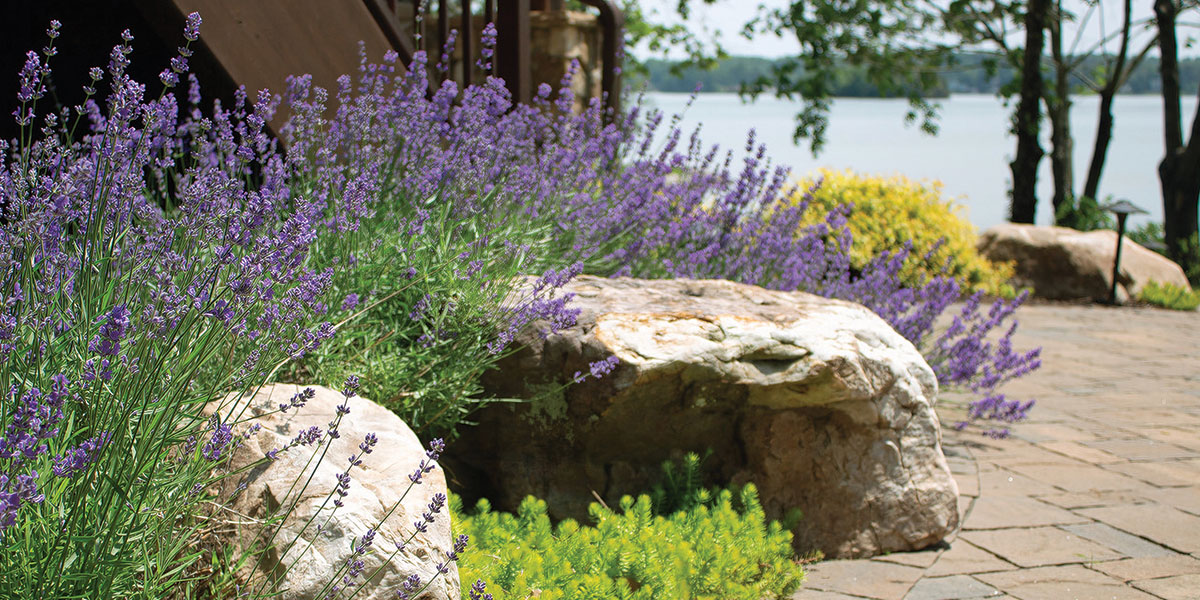 Photo Courtesy of Seven Oaks Landscape Hardscape
Photo Courtesy of Seven Oaks Landscape Hardscape
Protect the Lake and Add to Your Property’s Value with Buffer Landscaping
Those who are fortunate enough to live along a shoreline know there are benefits that come with that location. Being close to the water’s edge brings soothing views and a connection to nature that many people experience only occasionally. There are also unique challenges and obligations that come with proximity, as adjacent terrain plays a key role in the health of a body of water. That’s where buffer landscaping comes in.
Buffer landscaping is exactly what it sounds like: intentionally placed, deep-rooted plants that create a living safeguard, protecting nearby water from harmful run-off and stabilizing a shoreline that might otherwise be susceptible to erosion. While a lake might have its own ecosystem, it is still connected to the land around it. When developed lots sit alongside water, people have a responsibility to help manage what goes into that water.
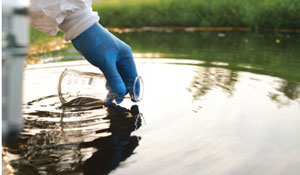 Water quality at the lake
Water quality at the lake
For the last 37 years, the Smith Mountain Lake Association (SMLA) has monitored Smith Mountain Lake’s water quality with the help of dozens of volunteers and ongoing collaboration with Ferrum College. Every two weeks during the summer season, volunteers visit 84 designated sites around the lake. They check water clarity and take samples that are later examined for levels of phosphorus, a nutrient that is essential for life but can have damaging effects at elevated levels and chlorophyll-a, an indicator of algal growth in the water. By monitoring these components, SMLA tracks the aging of the lake as well as identifies if algal growth may be overgrowing and leading to a “bloom.” Algae blooms can lead to depleted levels of oxygen in the water, and depending on what type of bloom is present, could be potentially harmful.
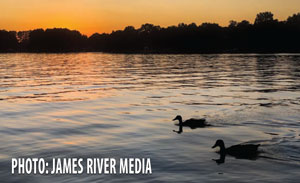 SMLA reports that the lake’s water clarity and phosphorus in the 2023 season are consistent with levels measured over the past 20 years, but chlorophyll-a levels were notably higher just this past year. The long-term stability in phosphorus levels, in particular, could be a result of SMLA’s dedicated effort since 2020 to encourage lakeside property owners to use low or no-phosphorus fertilizers, to add shoreline buffer gardens and improve awareness of the benefits of buffer landscaping. The occurrence of harmful algal blooms during the summer of 2023 at SML likely triggered elevated chlorophyll-a levels. The SMLA website provides gauges to depict water quality monitoring results and maintains an archive of all water quality monitoring reports.
SMLA reports that the lake’s water clarity and phosphorus in the 2023 season are consistent with levels measured over the past 20 years, but chlorophyll-a levels were notably higher just this past year. The long-term stability in phosphorus levels, in particular, could be a result of SMLA’s dedicated effort since 2020 to encourage lakeside property owners to use low or no-phosphorus fertilizers, to add shoreline buffer gardens and improve awareness of the benefits of buffer landscaping. The occurrence of harmful algal blooms during the summer of 2023 at SML likely triggered elevated chlorophyll-a levels. The SMLA website provides gauges to depict water quality monitoring results and maintains an archive of all water quality monitoring reports.
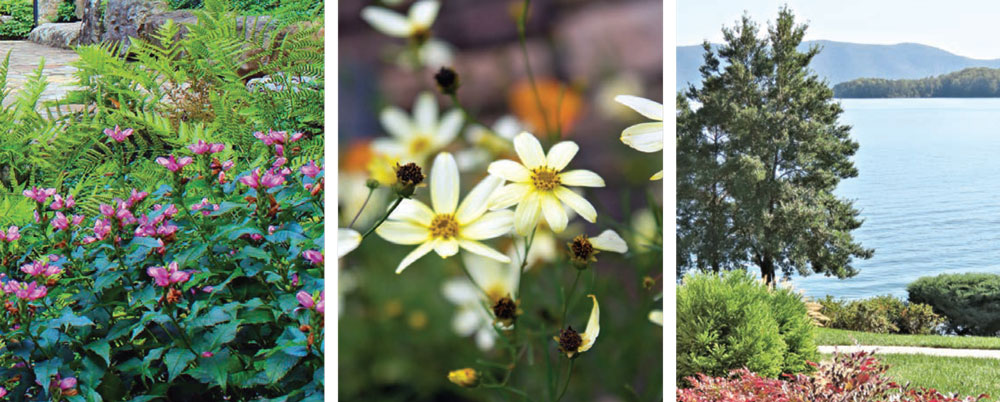 Photos Courtesy of Seven Oaks Landscape Hardscape
Photos Courtesy of Seven Oaks Landscape Hardscape
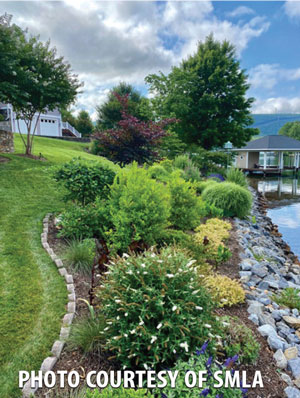 How buffer landscaping helps
How buffer landscaping helps
When homeowners create buffer beds or gardens, the benefits exist both close to home and well beyond property lines. For the homeowner, buffer landscaping adds visual interest, bringing in trees, shrubs and blooming perennials that can frame the view in a pleasing fashion, screen the property from passing water craft and even help minimize noise from the lake. Plantings also add to property value by stabilizing the shoreline through their root systems, which can minimize damage from the natural rise and fall of the lake level.
Thinking about the benefits beyond your own land, buffer landscaping helps the lake by retaining nutrients on the land by intercepting yard run-off, which often contains phosphorus-heavy fertilizer and other pollutants. Stabilization of the shoreline is also important for the lake, preventing additional soil from moving into the water. Adding riprap is another way to bolster the shoreline, but yard run-off moves through rocks directly into the water beyond, and a pile of rocks doesn’t offer the aesthetic appeal of carefully placed plants.
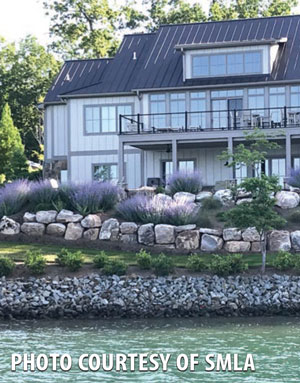 Homeowner resources
Homeowner resources
Homeowners have resources available when considering creating or adding to existing buffer landscaping. Start by contacting SMLA (theoffice@smlassociation.org) to request a visit from the association’s landscape advisory support team. Certified Master Gardeners and Master Naturalists visit homeowners free of charge to help assess what’s best for the site, considering the slope, what’s already in place and ultimate goals. They also provide a list of native plants and cultivars that do well around the lake. Remember: An APCO permit is required to remove shrubs and trees below the 800-foot contour but is not required to plant below the 800-foot contour line.
Property owners may also reach out to the Virginia Department of Conservation and Recreation Natural Heritage Program (www.dcr.virginia.gov/natural-heritage), which provides information about invasive plants to be avoided and native plants that will do well around the lake. As a plan is developed, be sure to consider variety – of size, blooming color and quantity – remembering that once planted, vegetation will only get bigger. If you want to keep that lovely view, be sure to check height at maturity before you put it in the ground.
It is vital to not only plant a buffer, but to also maintain it, according to Keri Green of SMLA. Watering problems and deer predation are the primary reasons that buffers fail. With a good plan for maintenance and upkeep, your plants should thrive. Don’t lose your initial planting investment by ignoring your buffer area.
With a thoughtful design, buffer landscaping will enhance the appearance of your property as a whole, plus give the satisfaction of knowing that you are doing your part to keep the lake healthy and welcoming for years to come. ✦
